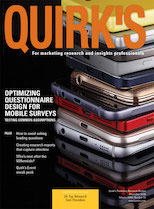Editor's note: Jesse Caesar is founder and CEO of Jesse Caesar Consulting, Brooklyn, N.Y.
We are all junkies now. Jonesing for the pleasures of repetitive rituals despite diminishing returns. Staggering through public places, oblivious to anything but getting our fix. Binging while the untended tasks mount and our eyes dry out. For those participating in the modern digital age, this is our blue-lit selfie.
As we become increasingly digitally connected, we are growing increasingly disconnected from one another. Loneliness is on the rise according to the UCLA Loneliness scale. So is the number of companies and publications pushing the practice of “digital detox.” What societal tension is this playing on? A Pew Research study revealed that the rates of technology adoption among Americans are going up, while inversely, our faith in the Internet as a positive social force is going down. Books examining the impact of the digital age on our social skills like Michaela Launerts’ #GirlCode: The Secret to Success in a Digital World outline how the FOMO generation is held back by anxiety over in-person interaction.
A Snap/Cassandra study of Gen Z revealed that 85 percent would rather have a small, close group of friends than a sprawling circle of associates but their favorite activities to engage with while with friends are almost all screen-based. We continue adopting more digital tools even though these modes of engagement bring us less satisfaction and erode our interpersonal skills.
The zombie hordes streaming through our devices are more than just a current mainstay of sci-fi – they’re a reflection of us. Perhaps it’s time to take that first step (with a decomposing stump dragging behind) and accept that we have a problem.
I’m no Luddite rallying for a full retreat to an analog lifestyle. The ubiquity of devices and Internet access brings us an ever-expanding bounty that I profoundly enjoy and rely upon. (Crafting and sharing this article sure would be a pain without access to those things.) Nevertheless, our always-on, always-updating culture is warping minds (and spines). We need a healthier balance. We need to create more space for face-to-face. Qualitative research provides a special opportunity for just that kind of rehab.
Fever pitch
Over the course of my moderating career I have seen my research participants’ urge to interact increase to a fever pitch. Keeping the discussion contained has grown more challenging in recent years. Even getting them to leave when the interview is over calls for more nudging now. This holds true for all in-person methodologies, across markets and in every demographic (young Millennials and Gen Z “digital natives” included). Unloading thoughts and feelings has always been cathartic for research participants but these days there is so much more to release. The other month a man in his early 20s hung back to talk to me about a sick relative – after an interview for window treatments.
This form of digital detox is a happy by-product of my professional approach. Interviews start with everyone turning off their phones. In a no-wrong-answers, judgement-free zone, they take the lead while I actively listen and follow up with empathic probes. To maintain engagement, I always try to sprinkle in some fun, creative exercises. Backs straighten, eyes lock and minds open.
While zombies might stagger into the room, they all can be brought to life through conversation. Study after study has demonstrated that people – no matter how device-dependent – still possess the fundamentals of interpersonal skills. I recently had a room of heavy smartphone users breathlessly building on one another’s real-word examples as well as more abstract thoughts to bring definition to the concept of thoughtful design. Give people the right forum and format and the floodgates will open.
Opportunities for companies
Tapping into this unmet need for IRL engagement presents a couple of opportunities for companies in any sector. One is providing compelling, non-digital interactive experiences as an activation or, better yet, as an ongoing part of their offering. Another is to team up with a qualitative pro to get to know their consumers.
Building businesses without connecting to customers or gnawing on the same old data bones makes companies zombie-like too. Let’s engage with real people, in real life. Let’s go out and eat some brains!
